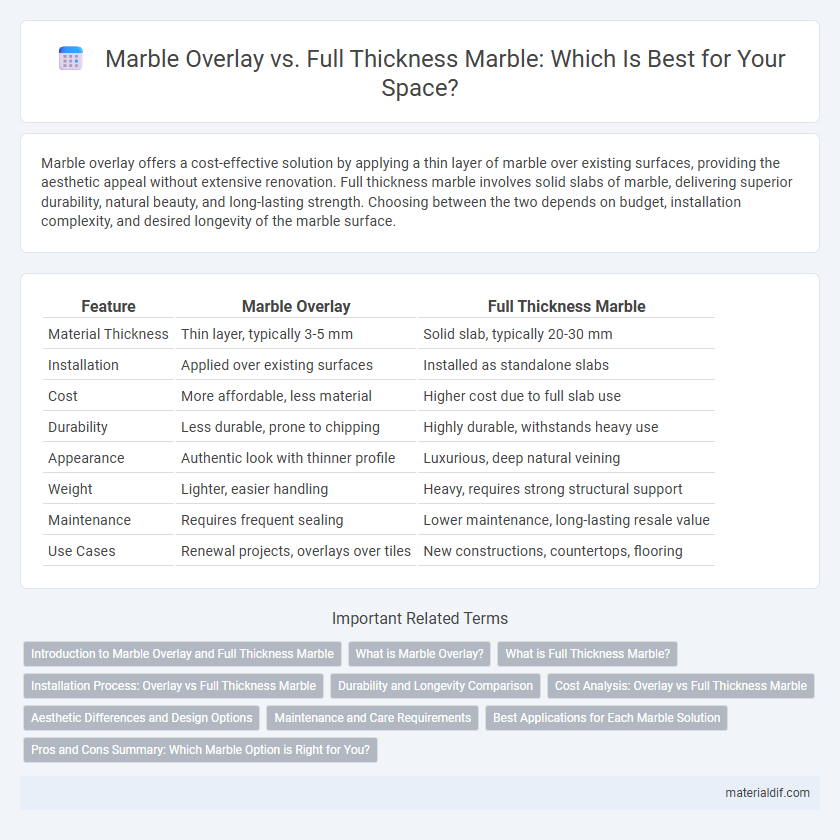Marble overlay offers a cost-effective solution by applying a thin layer of marble over existing surfaces, providing the aesthetic appeal without extensive renovation. Full thickness marble involves solid slabs of marble, delivering superior durability, natural beauty, and long-lasting strength. Choosing between the two depends on budget, installation complexity, and desired longevity of the marble surface.
Table of Comparison
| Feature | Marble Overlay | Full Thickness Marble |
|---|---|---|
| Material Thickness | Thin layer, typically 3-5 mm | Solid slab, typically 20-30 mm |
| Installation | Applied over existing surfaces | Installed as standalone slabs |
| Cost | More affordable, less material | Higher cost due to full slab use |
| Durability | Less durable, prone to chipping | Highly durable, withstands heavy use |
| Appearance | Authentic look with thinner profile | Luxurious, deep natural veining |
| Weight | Lighter, easier handling | Heavy, requires strong structural support |
| Maintenance | Requires frequent sealing | Lower maintenance, long-lasting resale value |
| Use Cases | Renewal projects, overlays over tiles | New constructions, countertops, flooring |
Introduction to Marble Overlay and Full Thickness Marble
Marble overlay consists of a thin layer of natural marble adhered to a surface, offering an affordable and versatile option for enhancing aesthetics without the weight and cost of full slabs. Full thickness marble slabs, typically ranging from 2 to 3 centimeters thick, provide durability and authentic marble appearance suitable for structural applications like countertops and flooring. Understanding the differences in thickness, installation methods, and cost implications helps in selecting the appropriate marble type for residential or commercial projects.
What is Marble Overlay?
Marble overlay is a thin layer of natural marble applied over existing surfaces to enhance aesthetic appeal without the need for complete replacement. This technique offers a cost-effective and less labor-intensive alternative compared to full thickness marble slabs, which involve using solid, thick marble pieces for flooring or countertops. Marble overlay provides the same elegant look and durability as full thickness marble while minimizing installation time and material waste.
What is Full Thickness Marble?
Full thickness marble refers to natural stone slabs cut in substantial thickness, typically ranging from 2 to 3 centimeters, offering enhanced durability and structural integrity. Unlike thinner overlays, full thickness marble maintains its original depth, making it ideal for high-traffic areas and heavy-duty surfaces such as countertops, flooring, and wall cladding. Its dense composition provides superior resistance to cracking and chipping, ensuring long-lasting beauty and functionality in architectural and design applications.
Installation Process: Overlay vs Full Thickness Marble
Marble overlay installation involves applying a thin layer of marble to an existing surface, requiring less labor, minimal surface preparation, and faster completion compared to full thickness marble. Full thickness marble installation demands extensive subfloor preparation, precise leveling, and longer curing times to support the heavier slabs. Choosing between overlay and full thickness marble impacts the overall project timeline, labor intensity, and structural requirements.
Durability and Longevity Comparison
Marble overlay offers a cost-effective solution with moderate durability, providing surface protection but relying on the underlying substrate for structural integrity. Full thickness marble slabs boast superior longevity and resilience, as their substantial thickness allows for natural resistance to wear, chipping, and environmental damage over time. Maintenance requirements for full thickness marble are generally lower, making it a more durable investment for high-traffic or heavy-use applications.
Cost Analysis: Overlay vs Full Thickness Marble
Marble overlay offers a cost-effective alternative by using a thin layer of marble applied over existing surfaces, significantly reducing material and labor expenses compared to full thickness marble slabs. Full thickness marble requires more raw material, intricate installation, and higher shipping costs, resulting in a substantially higher overall price. Choosing marble overlay can lower project budgets while maintaining aesthetic appeal, though it may sacrifice durability compared to solid, full thickness marble.
Aesthetic Differences and Design Options
Marble overlay offers a thin, customizable layer that enhances surfaces with intricate patterns and seamless integration, ideal for detailed aesthetic upgrades. Full thickness marble provides a more substantial, luxurious appearance with natural depth and variation, offering robust design flexibility for countertops, flooring, and wall cladding. Both options deliver unique visual appeal, but full thickness marble excels in durability and three-dimensional texture, while overlays excel in versatility and cost-efficiency.
Maintenance and Care Requirements
Marble overlay requires less intensive maintenance due to its thinner composition, making it easier to seal and clean regularly to prevent stains and etching. Full thickness marble demands more rigorous care, including frequent sealing and careful handling to avoid cracks, chips, and deeper damage because of its substantial depth. Both types benefit from pH-neutral cleaners and immediate spill wipe-up, but full thickness marble shows wear over time more noticeably due to its authentic, thicker structure.
Best Applications for Each Marble Solution
Marble overlay is ideal for enhancing countertops and walls where a thin, lightweight layer is sufficient to provide an upscale appearance without structural changes. Full thickness marble suits flooring, staircases, and heavy-use surfaces requiring durability, load-bearing strength, and natural stone integrity. Choosing marble overlay optimizes cost and installation speed, while full thickness marble ensures longevity and authentic stone quality in high-traffic or architectural projects.
Pros and Cons Summary: Which Marble Option is Right for You?
Marble overlay offers a cost-effective and less invasive alternative to full thickness marble, providing a quick surface upgrade with easier installation and lower weight, but it lacks the longevity and durability of a full slab. Full thickness marble ensures superior strength, natural beauty, and longevity, making it ideal for high-traffic areas and heavy use, though it requires higher investment and professional installation. Choosing between marble overlay and full thickness marble depends on budget, durability needs, and the desired aesthetic impact for your space.
Marble Overlay vs Full Thickness Marble Infographic

 materialdif.com
materialdif.com